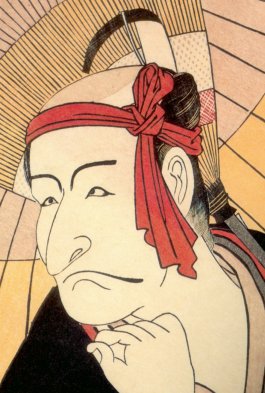

 Another example is the term "hachimachi" in the following picture (this is a game called しらのきせき made by my favorite game company Falcom, which, I heard, is not producing PC games anymore. I'm deeply sad). "Hachimaki" means headband, or 鉢巻. There are a few important things about 鉢巻: 1) 鉢巻--the kanji version--is a commonly used term (according to Denshi Jisho); 2) it's something that can be called "very Japanese" because non-Japanese people don't really wear headbands in the ways that Japanese people do. The question then becomes why did しらのきせき's game maker decide to write 鉢巻 in katakana, the writing system used mostly for foreign loanwords, onomatopoeia, and emphasis? I believe this decision to use ハチマキ instead of 鉢巻 or はちまき is, in fact, for emphasis, but not in the same way as how おやじ is written as オヤジ. First of all, the game has an imaginary but heavily Western industrial--sort of--setting. Due to the nature of the game, it would be awkward to have something that is "very Japanese" appear as an accessory on a game character. So perhaps the game maker want to use katakana to emphasize that this headband, hachimaki, is just a headband and no more. Therefore, katakana, in this case, is used to deemphasize the nativeness of the word.
Another example is the term "hachimachi" in the following picture (this is a game called しらのきせき made by my favorite game company Falcom, which, I heard, is not producing PC games anymore. I'm deeply sad). "Hachimaki" means headband, or 鉢巻. There are a few important things about 鉢巻: 1) 鉢巻--the kanji version--is a commonly used term (according to Denshi Jisho); 2) it's something that can be called "very Japanese" because non-Japanese people don't really wear headbands in the ways that Japanese people do. The question then becomes why did しらのきせき's game maker decide to write 鉢巻 in katakana, the writing system used mostly for foreign loanwords, onomatopoeia, and emphasis? I believe this decision to use ハチマキ instead of 鉢巻 or はちまき is, in fact, for emphasis, but not in the same way as how おやじ is written as オヤジ. First of all, the game has an imaginary but heavily Western industrial--sort of--setting. Due to the nature of the game, it would be awkward to have something that is "very Japanese" appear as an accessory on a game character. So perhaps the game maker want to use katakana to emphasize that this headband, hachimaki, is just a headband and no more. Therefore, katakana, in this case, is used to deemphasize the nativeness of the word. Why do most of the textbook examples given to us evade emphasis, whose use is as unclear and puzzling as I demonstrated in the previous two examples? I think there could be a few possible explanations. First of all, a textbook can't explain everything, especially an intro-level textbook. As a native Chinese speaker, I could not possibly imagine any book that can fully explain the uncountable subtleties of the Chinese language. The use of emphasis through katakana is sometimes painfully straightforward (like its use in loanwords and onomatopoeia), but it can be also very, very subtle. To fully understand those subtleties--to a point that we could use them with ease--requires us to have genuine, day-to-day interaction with Japanese people and culture for a very long time. Textbook explanations would never suffice. Therefore, these textbooks did what they could with explaining the overarching idea that katakana is used mainly for loanwords and onomatopoeia.
とても いい コメントですね! You pointed out 2 very interesting points! For the first one "オヤジ",
ReplyDeletemy opinion is that it shows the closeness between a speaker and "オヤジ". If you write "おやじ" in ひらがな, it seems very general and can be any "おやじ" . But by writing in カタカナ, it shows that the speaker is referring to a special "オヤジ".
I like your second analysis too! My opinion for this one is the other way around actually. I think they are trying to emphasis their "Japaneseness" in this foreign industry by using a Japanese word "ハチマキ" but still use カタカナ to make sure that foreign players will not feel distanced.
What do you think??
Great analysis! I totally agree that we can't fully understand the ways in which katakana is used from a textbook. The only way to truly understand any language or culture is to be immersed in it. Hopefully we'll all have a chance someday to spend time in Japan and develop a deeper understanding of the ways in which the language is used to express cultural ideals.
ReplyDeleteとても おもしろい アイデアです!amazing!
ReplyDeleteYour idea about オヤジ, in that situation, I think Katakana has the function of emphasis, too. But we also often use in the situation there is no need to emphasis that especially. So I guess, Katakana オヤジ also has other meaning as Ogata-san refered. I feel familiar to オヤジ than 親父 or おやじ when I call that character in Doragon ball!
I've never thought Katakana has the use of deemphasis, but I just realize I have to think it again more carefully including the idea you pointed out. Hachimaki is not common or usual fasion in Japan now. so Hachimaki does't mean " very Japane" for people who live in Japan either.
Excellent and informative analysis, but perhaps you also want to look at the larger scope of things and provide broader range of examples. You are absolutely right noting that only very extensive use of Japanese language and understanding the culture will actually yield better results of understanding katakana usage.
ReplyDeletevery interesting points!Your analysis made think the usage of katagana in other way around!Moreover, I am also truly agree that the usage of katagana do not present themselves in the textbooks but rather from communication embedded in daily life!
ReplyDelete